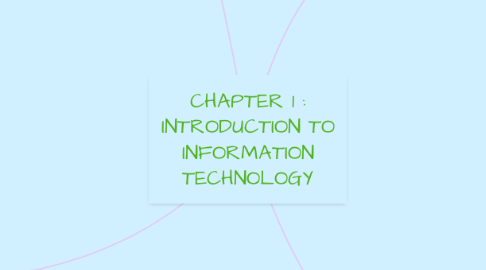
1. Definition
1.1. The use of computer hardware and software to store, retrieve, and manipulate information.
2. Advantages and disadvantages of information technology
2.1. Advantages
2.1.1. SPEED
2.1.2. RELIABILITY
2.1.3. CONSITENCY
2.1.4. STORAGE
2.1.5. COMMUNICATION
2.2. Disadvantages
2.2.1. HEALTH RISKS
2.2.2. VIOLATION OF PRIVACY
2.2.3. PUBLIC SAFETY
2.2.4. IMPACT ON LABOUR FORCE
2.2.5. IMPACT ON ENVIRONMENT
3. Applications of information technology
3.1. EDUCATION
3.1.1. Learning Management System
3.1.2. Computer Based Training
3.2. FINANCE
3.2.1. Finance Investment System
3.2.2. Online banking
3.3. GOVERNMENT
3.3.1. E-filing
3.3.2. E-Syariah
3.3.3. HRMIS
3.4. HEATLH CARE
3.4.1. Medline
3.4.2. Counter Registration System
3.4.3. Telemedicine
3.4.4. telesurgery
3.5. SCIENCE
3.5.1. Virtual Reality
3.5.2. Cochlear implant
3.5.3. Hawk Eye Officiating System
3.5.4. Neural network
3.6. PUBLISHING
3.6.1. Online Newspaper
3.6.2. Online Magazine
3.7. TRAVEL
3.7.1. global Positioning System(GPS)
3.7.2. Online Reservation System
3.7.3. e-ticketing
3.8. MANUFACTURING
3.8.1. Computer-Aided Design
3.8.2. Computer Aided Manufacturing
4. Categories of computer
4.1. SUPERCOMPUTERS
4.1.1. Fastest and most powerful computer
4.2. MAINFRAMES
4.2.1. Large, expensive and powerful computer
4.3. PERSONAL COMPUTERS
4.3.1. can perform all input, processing, output and storage activity by itself
4.4. MOBILE COMPUTERS
4.4.1. can carry from place to place : notebook computers,laptop computer
4.5. MOBILE DEVICES
4.5.1. small enough to hold in your hand : smart phone,e-book reader
4.6. EMBEDDED COMPUTERS
4.6.1. special purpose computer function as component in a large product : Antil lock brakers, airbag controller

